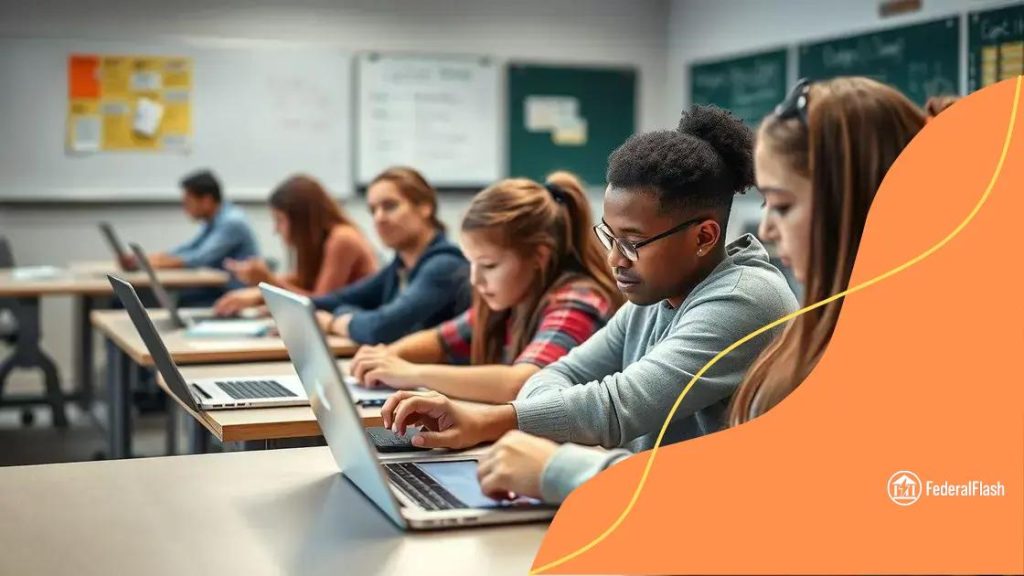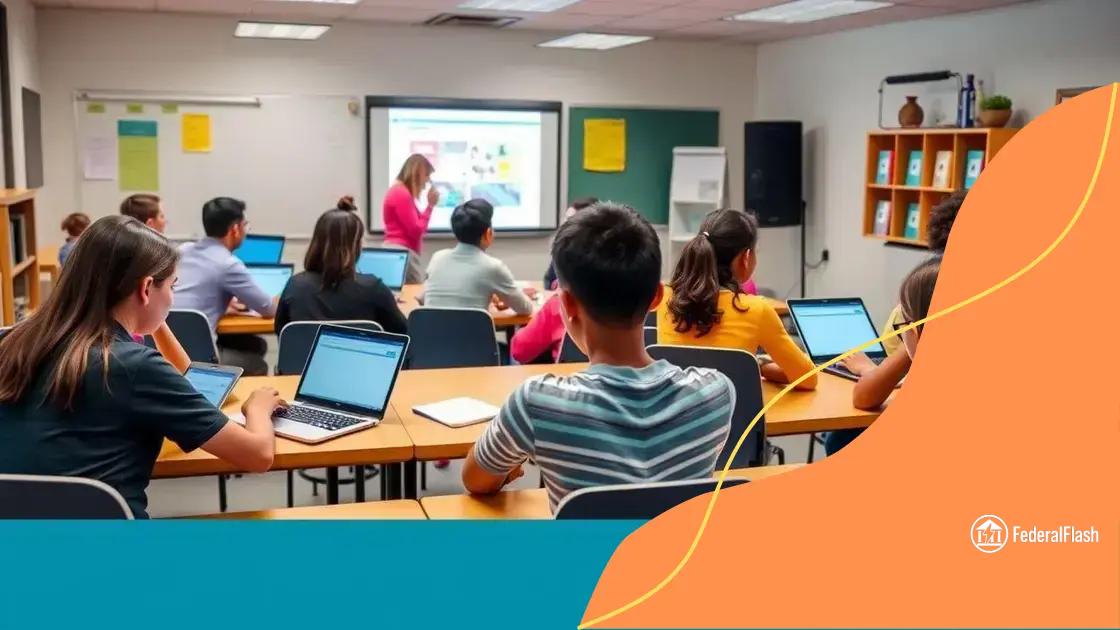Discussions about the role of technology in closing achievement gaps

Anúncios
Discussions about the role of technology in closing achievement gaps highlight that integrating digital tools can enhance student engagement and learning outcomes, making education more accessible and tailored to individual needs.
Discussions about the role of technology in closing achievement gaps have become increasingly relevant in today’s educational landscape. Have you ever wondered how innovations like online learning tools can change the game for students in underserved communities? Let’s dive into this topic!
Anúncios
Understanding achievement gaps in education
Understanding achievement gaps in education requires a closer look at the factors contributing to disparities among students. Various elements, such as socioeconomic status, access to resources, and educational support, play crucial roles in these differences. By examining these gaps, we can better identify the challenges students face and strive for solutions.
Key Factors Contributing to Achievement Gaps
Several aspects significantly influence the achievement gaps in education. Addressing these factors is essential for progress:
- Socioeconomic Status: Students from lower-income families often lack access to quality educational resources.
- Resource Availability: Schools in affluent areas typically offer more programs and experienced teachers, affecting student performance.
- Parental Involvement: A lack of engagement from parents can lead to lower student motivation and achievement.
- Language Barriers: Non-native speakers may struggle in an English-dominated curriculum, widening the gap.
As we explore these elements further, it’s clear that addressing achievement gaps requires a holistic approach. Understanding each factor helps in developing effective strategies tailored to meet students’ needs. For instance, targeted intervention programs can assist those who face challenges like lack of parental support or language barriers.
Anúncios
Furthermore, facilitating access to technology is one of the critical ways to bridge these gaps. Introducing digital tools in classrooms allows for personalized learning experiences that can adapt to individual student requirements. By leveraging technology, schools can level the playing field for all students, irrespective of their backgrounds.
The impact of technology on learning outcomes
The impact of technology on learning outcomes is profound and undeniable. As schools integrate more digital tools and resources, students often experience improved engagement and mastery of subjects. Using technology in the classroom enhances interaction and fosters a more dynamic learning environment.
Enhancing Student Engagement
By incorporating tech tools, educators can reach students in ways that resonate with their interests and learning styles. This engagement often leads to better academic performance. Different forms of technology, like tablets and interactive software, allow students to explore subjects in a more immersive manner, making learning feel more relevant.
- Interactive Learning: Tools like educational games and simulations can capture student interest and encourage exploration.
- Personalized Learning: Adaptive learning platforms provide tailored experiences based on individual student needs and pace.
- Immediate Feedback: Technology enables students to receive instant feedback, which helps them understand concepts more quickly.
- Increased Collaboration: Digital platforms can facilitate group work, allowing students to collaborate effectively, even from different locations.
Moreover, access to online resources expands learning opportunities beyond traditional textbooks. Students can now engage with a wealth of information, ranging from educational videos to interactive tutorials. This variety can cater to different learning preferences and encourages self-directed study.
The integration of technology also helps educators assess learning outcomes more effectively. Through data analytics, teachers can track student performance and identify areas where additional support may be needed. This data-driven approach allows for timely interventions that can positively influence student success.
Case studies of technology in classrooms

Case studies of technology in classrooms demonstrate how digital tools can enhance the learning experience. Each case provides insight into different ways technology is used effectively to engage students and improve educational outcomes.
Successful Implementations
Several schools have successfully integrated technology into their curriculum, showcasing its potential. For instance, a high school in California implemented a 1:1 laptop program, allowing every student to have a personal device. This initiative not only increased engagement but also improved students’ ability to complete assignments on time.
- Interactive Whiteboards: Classrooms equipped with smart boards enable teachers to present lessons engagingly, allowing for real-time interaction.
- Flipped Classrooms: In a flipped model, students review lecture materials at home through video content and engage in hands-on activities during class time.
- Online Learning Platforms: Utilizing platforms like Google Classroom helps streamline assignments and feedback, promoting better communication between students and teachers.
- Virtual Reality Expeditions: One middle school introduced VR technology, allowing students to explore historical sites and scientific concepts in immersive environments, fostering deeper understanding.
These examples illustrate that when technology is integrated thoughtfully, it can have a lasting impact on education. The ability to personalize learning experiences caters to various student needs, making education more accessible and engaging.
Moreover, the use of analytics tools in the classroom also helps educators track progress effectively. For example, a school district in Texas used learning analytics to identify gaps in student comprehension and modified its teaching strategies accordingly. This data-driven approach is crucial for adapting instruction and providing targeted support.
Challenges and solutions in tech integration
Challenges and solutions in tech integration are crucial for educators and administrators to understand as they work to enhance learning environments. Many schools face barriers when integrating technology into their classrooms, affecting overall effectiveness.
Common Challenges
One significant challenge is the lack of sufficient training for teachers on how to effectively use new technologies. This gap can lead to underutilization of valuable resources and hinder student engagement. Additionally, limited access to reliable internet and devices can impair students’ ability to fully participate in tech-enhanced learning experiences.
- Resource Limitations: Not all schools have the budget to provide laptops or tablets for every student.
- Teacher Preparedness: Many educators may feel overwhelmed by new software, leading to inconsistency in classroom application.
- Resistance to Change: Some staff members may prefer traditional teaching methods, making integration difficult.
- Equity Issues: Disparities in technology access can widen achievement gaps among students.
Despite these challenges, several effective solutions have emerged to facilitate greater technology integration. Professional development workshops can empower teachers with the necessary skills to confidently incorporate tech tools into their classrooms. Moreover, schools can partner with local organizations or businesses to secure additional resources and funding for technology initiatives.
Furthermore, creating a supportive environment where students can experiment with technology helps foster a culture of innovation. Allowing students to explore tech tools can increase their comfort level, leading to more active participation in their learning process. Introducing mentoring programs where tech-savvy students assist their peers can also help close the gap in technology utilization.
Future trends in educational technology
Future trends in educational technology promise exciting changes that can enhance learning experiences for students and teachers alike. As technology continues to evolve, new tools and methods will reshape the classroom environment.
Emerging Technologies
One of the most significant trends is the rise of artificial intelligence (AI) in education. AI can provide personalized learning experiences by adapting to each student’s pace and style. For example, AI-driven platforms can analyze student performance to suggest tailored resources, making learning more efficient.
- Virtual Reality (VR): VR offers immersive experiences that allow students to explore topics in a more engaging way, such as visiting historical sites or conducting science experiments.
- Augmented Reality (AR): AR can overlay digital information in real-world settings, helping students visualize concepts and stay interactive with their lessons.
- Gamification: Incorporating game-like elements, such as rewards and challenges, into lessons can boost student motivation and engagement.
- Data Analytics: Schools will increasingly use data analytics to track student progress and improve instructional methods based on performance trends.
Additionally, the expansion of remote learning tools will pave the way for flexible education. Students can learn from anywhere, which is especially useful for those with different needs or circumstances. Online platforms now allow for a blend of synchronous and asynchronous learning, providing students with the options that best fit their lives.
Moreover, a focus on digital citizenship will be essential. As technology becomes more integrated into education, students must learn how to navigate the digital world safely and responsibly. Programs that teach skills around online ethics and communication are becoming crucial in the curriculum.
technology in education opens up new possibilities for improving student engagement and learning outcomes. By understanding the challenges and actively seeking solutions, educators can successfully implement tech tools in classrooms. As we look to the future, trends such as AI, VR, and personalized learning will continue to shape the way students learn, making education more accessible and engaging for everyone. The goal is to foster a generation of learners who are not only tech-savvy but also capable of navigating the digital landscape responsibly.
FAQ – Questions about technology in education
How can technology improve student engagement?
Technology can enhance student engagement by providing interactive and personalized learning experiences that cater to individual interests.
What are some emerging technologies in education?
Emerging technologies in education include artificial intelligence, virtual reality, and gamification, all of which create more immersive learning environments.
How does data analytics help teachers?
Data analytics allows teachers to track student performance in real-time, enabling them to tailor their instruction based on individual learning needs.
What is digital citizenship and why is it important?
Digital citizenship teaches students to navigate the internet safely and responsibly, preparing them for lifelong success in a digital world.